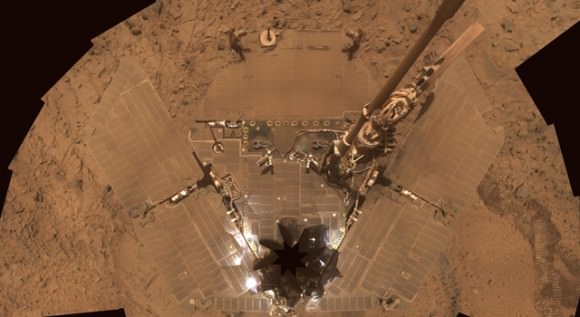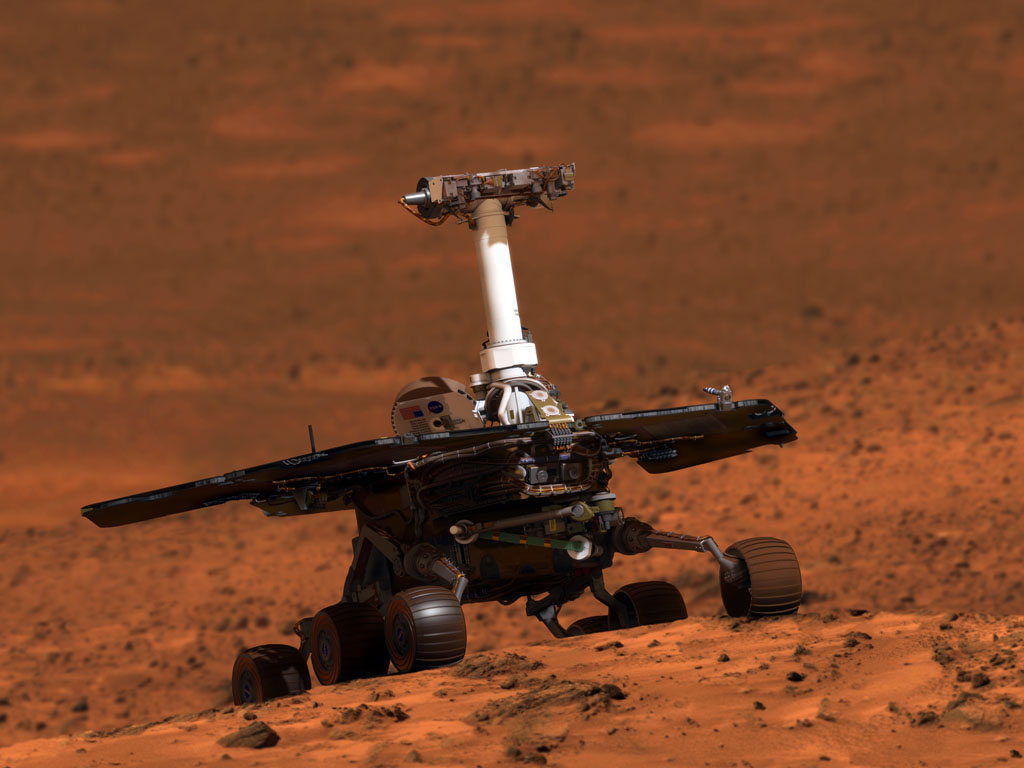Mission managers for the Mars Exploration Rover program announced this week that the Spirit rover will likely never rove again on Mars. But that doesn’t mean her life is over. However, with the rover virtually immobile and stuck in a sand trap, she currently is in a very vulnerable and potentially “deadly” situation as winter approaches on Mars’ southern hemisphere. Pointing the rover’s solar panels towards the sun is critical if the rover is to survive, and the rover team has just a handful of drives to make it so. And the winters are long and harsh on Mars. “The temperatures will be colder than anything Spirit has experienced before,” said John Callas, project manager for the MER mission. “This is a much more difficult and dangerous situation for Spirit, and we’re heading into a regime where vehicle is going to get colder than it ever has.”
What is Spirit facing, and what are her odds?
“Spirit will be experiencing decreasing power levels, and we will likely see energy levels that will drop below 160 watt hours,” said Callas, which is the level of power the rover needs to maintain so it can communicate daily with Earth. “If we can’t maintain that level, that will trip a low power fault where the rover shuts down or hibernates, taking the necessary steps to preserve as much power as possible. Everything is turned off except the master clock, and all the photons that hit solar arrays go into charging the batteries.”
In this low-power fault, a timer wakes the rover up occasionally to check battery levels, and if there is enough power, Spirit will wake up enough to see how charged the batteries are and attempt to communicate with Earth. “Spirit will be like a polar bear hibernating, possibly for several months, maybe on the order of 6 months that the rover will be in this state,” said Callas. “It won’t be like the Phoenix lander where it shuts down virtually completely. The rover will still be electrically active, but not with enough power to be awake each day.”
Callas predicted it will be in the March-April time frame here on Earth when they run out of ability to communicate with rover because there won’t be enough power.
Normally the rover stays warm enough simply by being “on” and running, like running your car in the winter to warm it up. But since rover will be deeply sleeping, temperatures on the rover will drop.
Callas and his team are concerned that temperatures on the rover will get very cold. Based on past winters, they expect about -40 to -50 C temperatures on Mars during the depths of winter. The electronics on the rover can withstand -40 degrees C when operating and -50 c when the rover is idle. But these standards are for a brand-new out-of-the-box rover, Callas said, not a 6 year-old rover with electronics have gone through many different temperature cycles.
Ironically, the fumaroles or steam vents that likely created the very scientifically rich “Troy” area where Spirit sits would have made it a “hot spot” on Mars. But, of course, the fumaroles are no longer active.
The rovers do have three 1-watt Radioisotope Heater Units (RHUs) which are tiny thermal heating units used to keep motors and batteries warm on the rover, so Spirit’s important insides will not get as cold as the outside.
But power from the solar panels is very important for keeping the computer and other electronics active, and right now, the position of the solar panels is not at all optimal.
“Our primary mission is to get solar panels pointed toward sun improve her chances,” said rover driver Ashley Stroupe. “Ideally the solar panels should be pointed toward the sun, to maximize the energy the rover receives. If we can get enough power to keep the rover warm, that will shorten the amount of time Spirit may have to be in a low power state.”
In upcoming drives, the team will try to get left rear wheel of the rover lifted up, by driving backward and improving its northerly tilt. Spirit is sitting in a small crater with the rim behind her, so as it moves backwards, it is slowly climbing up on the rim, tilting the rover. “On the last drive we saw 1-2 degree improvement in tilt,” Stroupe said on Tuesday. “So we’re going to do as much improvement as we can by continuing to drive backward. We can an also attempt to rotate the rover in place, so that the roll isn’t pointed as much towards the south as it is now.”

Each degree of tilt towards the north gains 5 watt hours of improvement. One upside is that the solar panels are currently fairly free of dust accumulation.
When the rover attempts to wake up each day, it will be at about noon local time on Mars, when the electronics will have warmed up because of sunlight.
But there’s the possibility the team might not hear from the rover for months.
“We have to be prepared to go through a period like this,” said Callas. “We may not hear from rover, and it will be frustrating and challenging for the team, but we’ll have to be disciplined about this, and hopefully when power resumes we can resume communication in the spring.”

And, worst case scenario, where is a very long period of time where they don’t hear from the rover, how long will the team attempt to communicate with Spirit?
“That’s a very complex problem,” Callas told Universe Today at the Tuesday’s press conference. “The rover will actually experience two levels of fault protection. The rover takes action based on hearing from Earth, and if we go too long without talking to the rover, it trips an up loss timer. We only keep about 6 weeks of communication tables on the rover, so that likely will have run out. All these things make for a complex recovery effort for the rover. It is hard to say how long we would try, because we would have to try many things before we exhaust the list of things we can do.”
Callas didn’t want to give odds if Spirit will make it through the winter. “Spirit’s best chance for survival is when we can stay in contact with her,” he said. “As long as we can maintain communication with rover we can look out for trouble, and advise her on how to best reapportion her limited resources.”
MER PI Steve Squyres said not having a roving rover is a “poignant moment” for the team. “We built the rovers to drive around, so we have shifted our focus to a different class of activities. It is a change and one we’ll have to adapt to. But this is a much better way that having an abrupt end to the mission, which would preclude doing the kind of science we’re looking forward to.” (Read more about the science Spirit can do in our earlier article)
“We have hope that Spirit will survive this cold dark winter that Spirit has ahead of her,” Squyres said.


The rovers are in need of replacement. Another rover program is needed. Unfortunately the exo-mars program is not going to get there until later this decade. We are likely to be blind on the martian surface for a while. Spirit is probably going to die soon and Opportunity will probably run into some problem before terribly long.
LC
Got to share this:
http://xkcd.com/695/
=)